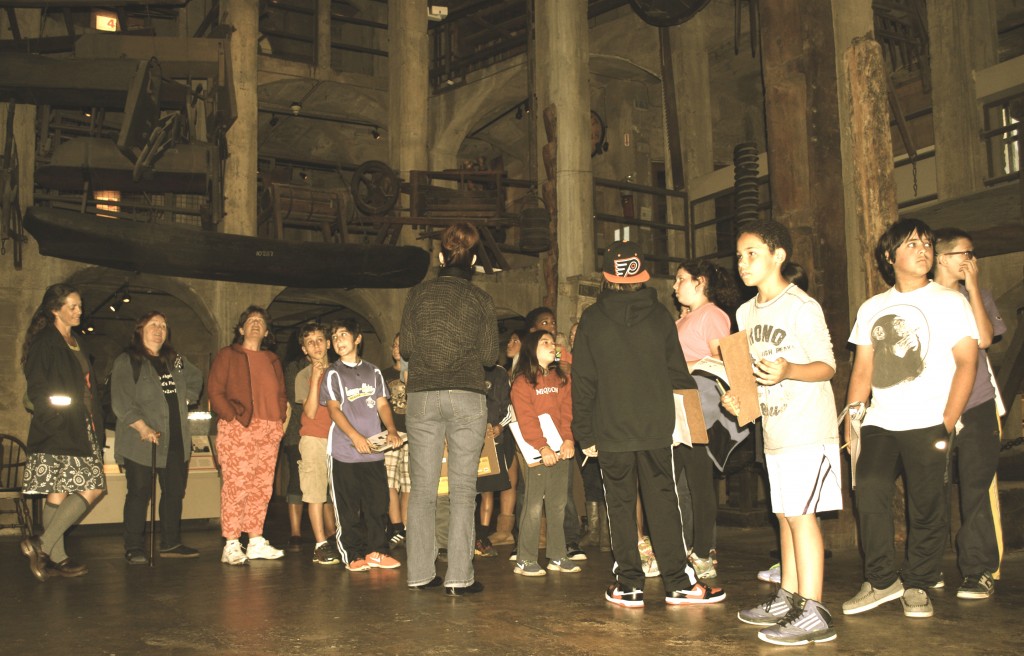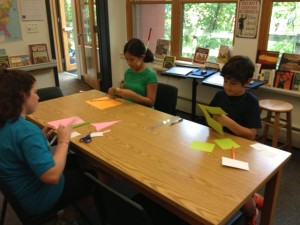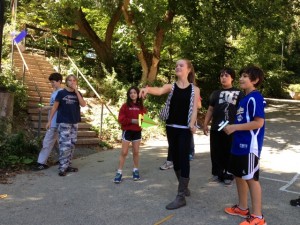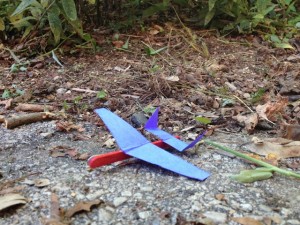Our wagon trains rolled out of Ft. Independence this week, and our pioneers have already had some unfortunate events. You might ask your child about that, if you didn’t hear already.
We started our spelling program, practicng words that are likely to be written often in our trail journals: biscuit, Cheyenne, desert (instead of dessert), and the like.
But a major highlight of the week was our trip to the Mercer Museum. Our thanks go to the mothers of Jonah, Trevi, and Jacob for driving and leading small groups on their explorations. We took our wagon-packing lists and found an amazing number of things that people would have had in that time, not all of which might have fit into the wagon. As it happened, there was also a new, unrelated exhibit about the ancient Mayans and the work of archaeologists, which we also had time to see.

Here are some comments from our group about what they saw, thought, and learned . . .
(Jonah) I saw a lot of cool things. I learned that it took a lot of time to make clothing. I wondered how they got everything up on the ceiling.
(Trevi) I loved learning about specifically the wagon’s outside. I saw so much dust you could take a handful of it. But it was so interesting because they said they had all the original pieces. They also said that they haven’t cleaned since Henry Mercer put them there. The Mayan exhibit was so cool. They had all sorts of puzzles, caves, maps, and you could even get bitten by a spider.
Chloe) I thought the Mercer Museum was really cool. I especially liked how they would hang things on the ceiling. I also thought the Mayan exhibit was really cool because I liked how the exhibit let you touch things. In the actual exhibit I liked the dog footprints.
(Caden) At the Mercer Museum, I really liked the Mayan exhibit. One of the things I learned was that the Mayans had three calenders. They believed that if they all ended on the same day, the world would end. That is why they added a few extra days to one of the calendars. My favorite activity in the exhibit was there were symbols and you had to figure out which ones would light up. If you pressed on one that didn’t light up, you would have to start over again. If you got all of them right, the treasure would light up. In the actual exhibit, I liked the stairs that the dog stepped on when the cement was still wet. I thought it was cool to see the footprints in the cement.
(Hannah) I enjoyed the trip to the Mercer Museum a lot. They had a side exhibit about the Mayans. My favorite part there were the spiders. Over a little cave opening in the wall it said, danger, there may be vicious spiders. We dared one of the people in our group to stick their hand in. She said it wasn’t scary at all. I stuck my hand in next. Instead of a spider bite, it was just air blasting on my hand. Everyone else tried it but Adelaide. Finally she mustered all her courage and stuck her hand in. She had to agree, it wasn’t scary at all. Why did they use air to represent the spider bite?
(Kai) The trip to the museum was very fun. The Mayan exhibit was very cool. I really like it because it was fun trying to match up different symbols to light this window up to show you some Mayan Necklaces. And it was fun putting your hand in the spider bite thing. It scared everyone but it was only air blowing on your hand.
(Luca) I wonder why they don’t clean the artifacts in the museum. They let it sit and rot,collect dust and get moldy. I think they should clean the historic pieces of junk!
(Clara) I really liked the Mercer Museum. The one thing I really enjoyed is that there were activities and you did not have to just read stuff, but there were activities that you would do, but you would also learn stuff. The one activity that I really liked is that you would put your hand in a little slot and it would squirt out air and it would try to be like a spider was biting you. I liked how there were tools, kitchen utensils, and much other stuff hanging from the ceiling, and there were 7 floors in the museum so you would see all those things from different perspective . I also loved the Mayan exhibit.It was really interesting. It had different tents and there would be different things to learn about. Overall, I think it was amazing to see everything. I learned a lot.
(Juniper) Something interesting that I learned was that they made combs out of turtle shell and horns. I knew that they made things out of horns and turtle shells, but never combs. Also, the combs there were really cool, and it was interesting to imagine how much work they put into it.
(Izzy) At the Mercer Museum, I learned that the Mayans used a lot of the same constellations, like Orion and the giant scorpion. I also learned that at the yard sale he bought most of the merchandise from, everything was one cent.
(Sofia) I was really surprised about those tortoise shell combs. They had so many designs, and little designs, I didn’t know such thing was possible. The wagon was also amazing! I can’t believe that it can hold 1,500 BWU! They also had a side exhibit about the Mayan Medallion. I thought the setting was nice, and the shaky bridge was really realistic.
(Adelaide) The trip to the Mercer Museum was very interesting and fun. They had an exhibit about the Mayans beside the main collection. One of my favorite parts of the Mayan exhibit was the spider bite. There was a little opening that you were supposed to put your hand in, and it was supposed to feel like a spider bit you. At first I was so scared to do it. Then after most of my friends did it, I worked up the courage and stuck my hand in. All it felt like was air! I guess it was supposed to be kind of like a shot. It is so quick that you don’t even feel anything.
(Damien) I thought that the Mercer Museum and the Mayan exhibit were really cool. The spider in the Mayan museum was really cool, and I liked that it was so interactive. I learned that a fiddle was violin because I always that that a fiddle was a recorder, and I also learned that wagons are a lot smaller than you think. It was cool that they put dog prints around the museum. I wonder about the weird pottery stuff at floor six. Another thing I learned about the Mayan exhibit is how to tell the difference between a male skeleton and a female.
(Gabe) In the Mayan exhibit I learned how to count in the Mayan language. They use lines and dots:
| (line) = 5 • (dot)=1 | | • (line line dot) =11 | ••• (line dot dot dot)=8
(Annika) I thought that the Mercer Museum was very interesting because there were so many different things there that I had never seen before. I especially liked the Mayan exhibit because there were lots of cool things about how the Mayans lived and what kinds of creatures that they lived with. They had a dead tarantula! Another thing that I liked was the clocks. I thought that was interesting because the clocks were so big and complicated.
(Jacob) I thought that the trip to the Mercer Museum was very interesting. I liked how the objects were all over the place. I also liked how the Mayan exhibit was very interactive and fun. It was cool that the dog walked up the stairs and left paw prints in the wet cement. I learned that they used a corn sheller to get the corn off the cob, and I never knew how they did it. I also learned how to tell the difference between the skeleton of a man and a woman. All and all, it was a cool trip.










